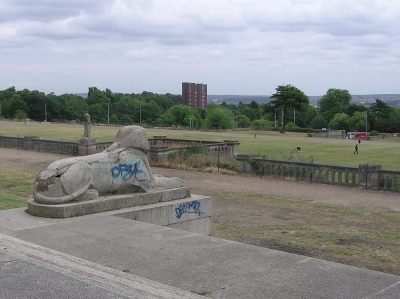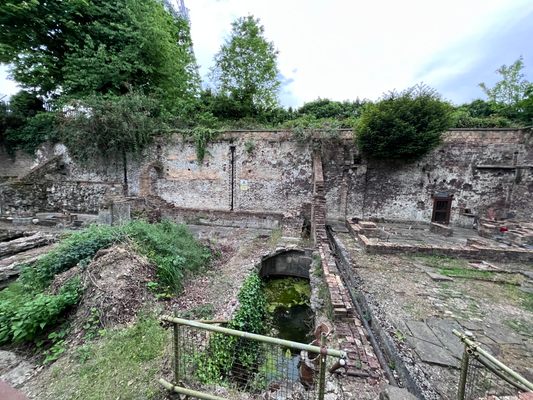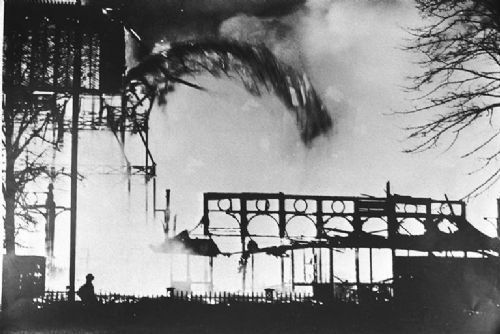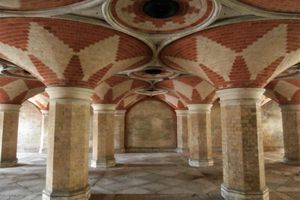About
It is difficult to imagine the enormous glass masterpiece of Victorian engineering that once stood on this spot. Only the foundations remain; together with a few stairwells guarded by an old sphinx, and some internal foundation stones.
In 1936 a great fire lit the London horizon, but the efforts of 381 firemen with 89 engines were not enough to stop the blaze. Arson or accident, it was destroyed beyond saving.
The Crystal Palace was originally built to house the Great London Exhibition of 1851, a World's Fair-type expo highlighting the wonders of technology and arts of Great Britain's far-flung empire. Engineer Joseph Paxton was inspired by the underlying structure of the giant water lily to create ever larger conservatory buildings, culminating in the design of the spectacularly large exhibition hall, which he designed in just 10 days (his original sketch is now in the Victoria and Albert Museum).
Taking advantage of new modular design innovations, the 108-foot-tall building was able to be assembled in record time. A newly constructed railroad brought the tons of timber and iron, and 10 million feet of glass to the original Hyde Park location, where the exposition opened on May 1, 1851, just a little over nine months from the initial design.
It was an intentionally elaborate and showy building, and became famous almost immediately. It was, however, not universally loved. August Welby Pugin, a proponent of Gothic architecture, called it a "glass-monster" and even told Paxton "You had better keep to building greenhouses, and I will keep to my churches and cathedrals"(Harrison). Thomas Carlyle called it a "big glass soap bubble", and John Ruskin a "conservatory"."
Although it was originally intended only as a temporary structure, in 1854, after the close of the exhibition, the palace was moved to a permanent location at Sydenham in southeast London, where it was surrounded by elaborate gardens and became home to an eclectic assortment of attractions intended to draw back the crowds. Two new 280-foot-tall water towers designed by Isambard Kingdom Brunel powered fountains that launched jets of water 120 feet in the air. The Dinosaur Court sculpture garden showing off recently discovered prehistoric beasts was added on the grounds, now a protected landmark still visible today.
In 1866, the first of several fires struck, destroying the north transept. A gigantic aquarium opened in place of the lost transept in 1871, the largest in the world, hosting over 300 species and requiring 120,000 gallons of saltwater pumped in from Brighton. In the 1890s, the fish were replaced with monkeys. Festivals and cricket matches were held on the grounds, along with roller coasters and hot air balloon rides.
But by the turn of the century, the palace was losing money and declared bankruptcy in 1911. The fountains were turned off, and Brunel's huge water towers emptied. So when the building caught fire in 1936, there was no water on hand to put out the blaze. The towers made it through the fire, but were destroyed in World War II for fear that they were easy markers for German bombers.
Another organization formed in 2008 is dedicated to efforts to rebuild a 2/3 size Crystal Palace at Sydenham. The new plans call for a building that is an homage to the original, but with shops, a hotel, underground parking, an enormous waterfall, and something referred to as "Hanging Gardens" included in the design. The grounds would be updated with sporting fields, RV parking, and other modern attractions. It is unclear whether the plans have moved beyond mere suggestion, however.
Related Tags
Know Before You Go
The building is at the end of the park nearest Crystal Palace station and the terminus of the number 3 bus route from Whitehall and Brixton. There is parking directly opposite the park. The remains of the Crystal Palace aquarium are located at the end of Old Cople Lane.
Community Contributors
Added By
Published
December 29, 2009
Sources
- http://hdl.handle.net/1903.1/20
- http://www.crystalpalacefoundation.org.uk/history/default.asp?id=6
- http://en.wikipedia.org/wiki/Joseph_Paxton
- http://www.bbc.co.uk/london/content/articles/2004/07/27/history_feature.shtml
- http://www.transdiffusion.org/emc/baird/baird_itv.php
- http://www.victorianweb.org/history/1851/engineers.html
- http://www.guardian.co.uk/society/2007/apr/29/communities.artnews
- http://en.wikipedia.org/wiki/The_Crystal_Palace
- http://www.bbc.co.uk/london/in_pictures/360_degree/crystal_palace/index.shtml
- http://www.crystalpalacecampaign.org/
- http://www.urban75.org/london/crystal-palace-photos.html
- http://www.victorianstation.com/palace.html
- http://www.ric.edu/faculty/rpotter/cryspal.html
- http://www2.iath.virginia.edu/london/model/
- http://www.thisislondon.co.uk/standard/article-23436111-will-crystal-palace-rise-again.do
- http://www.newcrystalpalace.org/





















































































